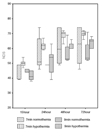Quantitative EEG and neurological recovery with therapeutic hypothermia after asphyxial cardiac arrest in rats
- PMID: 16919609
- PMCID: PMC3074257
- DOI: 10.1016/j.brainres.2006.04.121
Quantitative EEG and neurological recovery with therapeutic hypothermia after asphyxial cardiac arrest in rats
Abstract
We test the hypothesis that quantitative electroencephalogram (qEEG) can be used to objectively assess functional electrophysiological recovery of brain after hypothermia in an asphyxial cardiac arrest rodent model. Twenty-eight rats were randomly subjected to 7-min (n = 14) and 9-min (n = 14) asphyxia times. One half of each group (n = 7) was randomly subjected to hypothermia (T = 33 degrees C for 12 h) and the other half (n = 7) to normothermia (T = 37 degrees C). Continuous physiologic monitoring of blood pressure, EEG, and core body temperature monitoring and intermittent arterial blood gas (ABG) analysis was undertaken. Neurological recovery after resuscitation was monitored using serial Neurological Deficit Score (NDS) calculation and qEEG analysis. Information Quantity (IQ), a previously validated measure of relative EEG entropy, was employed to monitor electrical recovery. The experiment demonstrated greater recovery of IQ in rats treated with hypothermia compared to normothermic controls in both injury groups (P < 0.05). The 72-h NDS of the hypothermia group was also significantly improved compared to the normothermia group (P < 0.05). IQ values measured at 4 h had a strong correlation with the primary neurological outcome measure, 72-h NDS score (Pearson correlation 0.746, 2-tailed significance <0.001). IQ is sensitive to the acceleration of neurological recovery as measured NDS after asphyxial cardiac arrest known to occur with induced hypothermia. These results demonstrate the potential utility of qEEG-IQ to track the response to neuroprotective hypothermia during the early phase of recovery from cardiac arrest.
Figures




References
-
- Antonini M, Barladu M, Mathieu P, Daubechies I. Image coding using wavelet transform. IEEE Trans. Image Process. 1992;1:205–220. - PubMed
-
- Ao H, Tanimoto H, Yoshitake A, Moon JK, Terasaki H. Long-term mild hypothermia with extracorporeal lung and heart assist improves survival from prolonged cardiac arrest in dogs. Resuscitation. 2001;48:163–174. - PubMed
-
- Bedell SE, Delbanco TL, Cook EF, Epstein FH. Survival after cardiopulmonary resuscitation in the hospital. N. Engl. J. Med. 1983;309:569–576. - PubMed
-
- Berek K, Jeschow M, Aichner F. The prognostication of cerebral hypoxia after out of hospital cardiac arrest in adults. Eur. Neurol. 1997;37:135–145. - PubMed
Publication types
MeSH terms
Grants and funding
LinkOut - more resources
Full Text Sources
Medical

